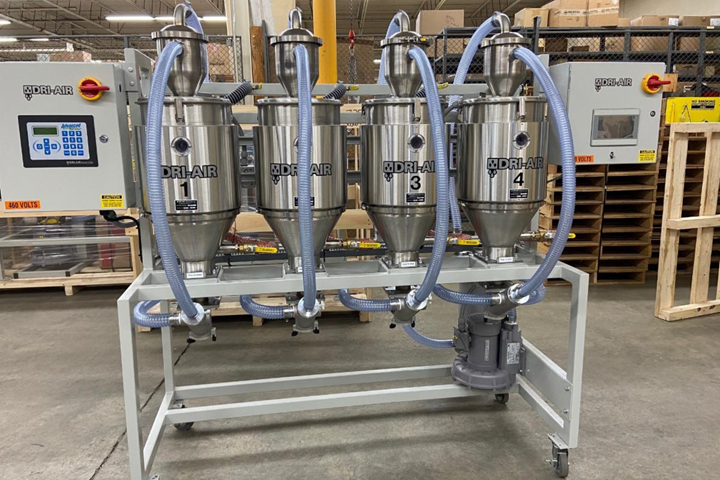Crystallizing Dryer for Small Batches
Resin is crystallized and dried with the same desiccant dryer that is used to supply dry air to the hopper bank.
For processors who would like to crystallize small batches of PET and other amorphous resins, Dri-Air has integrated a closed loop dry-air recirculating system into the hopper bank, allowing for crystallizing and drying of multiple batches of materials.
Complete flexibility is designed into the system so that temperatures, hold times and recirculating times can be custom tailored for each hopper. This allows processors to crystallize different types of materials for multiple batch processing.
A reportedly unique feature of the Dri-Air crystallizing system is that the resin is crystallized and dried with the same desiccant dryer that is used to supply dry air to the hopper bank. Eliminating the need to dry the resin in a separate dryer after crystallizing has occurred saves time and effort. Simply switch the system to drying mode and the resin in the hopper will be dried to the correct moisture levels.
Because this option is available on the hopper-bank platform, processor are able to dry crystallized resin in some of the hoppers while crystallizing resins in the others.

Related Content
-
Resin Drying Hoppers Offer More Energy Efficiency, Durability and Cleanability
NPE2024: Drying hoppers provide improved energy efficiency and a durable textured metal exterior finish. Thicker insulation provides a cooler working environment, while polished stainless steel interiors resist material entrapment, and make cleanouts and changeovers faster.
-
Novel Hopper Design for More Efficient Resin Drying
Patented internal geometry and unique thermodynamic properties significantly enhance the drying process, offering a 33% reduction in drying time compared to traditional systems.
-
How to Effectively Reduce Costs with Smart Auxiliaries Technology
As drying, blending and conveying technologies grow more sophisticated, they offer processors great opportunities to reduce cost through better energy efficiency, smaller equipment footprints, reduced scrap and quicker changeovers. Increased throughput and better utilization of primary processing equipment and manpower are the results.

